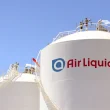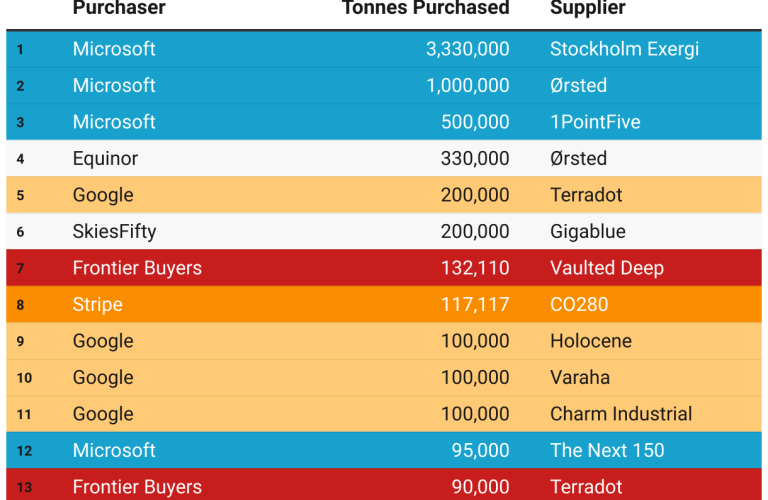The carbon removal market experienced significant growth in 2024, with the volume of carbon removal credits increasing by 78% to eight million tonnes, according to a new report by CDR.fyi. The surge reflects the increasing demand for carbon removal solutions as part of global climate action efforts. However, while demand from major technology firms remains strong, broader market participation and cost challenges pose concerns for long-term stability.
The expansion of the carbon removal market has been largely driven by repeat buyers, including Microsoft, Google, and Stripe, which accounted for nearly 80% of total purchases. While total credit sales increased, the number of companies purchasing them grew by just 7%, rising from 202 to 216. Microsoft remained the market leader, securing 5.1 million tonnes of credits, which represented 63% of total purchases—a slight decline from its 70% market share in 2023. Google expanded its direct purchases to 500,000 tonnes, and Meta pledged $35 million in carbon credits, though its allocation between durable carbon removal and nature-based solutions remains unclear.
In a significant collaboration, Microsoft, Google, Meta, and Salesforce formed the Symbiosis Coalition, pledging to purchase 20 million tonnes of nature-based carbon removal credits by 2030. While these commitments highlight the growing importance of carbon removal investments, the lack of new buyers in the market raises concerns about long-term stability.
Despite the rising demand, supply-side challenges persist. Only 36% of carbon removal suppliers listed on CDR.fyi recorded a sale in 2024, highlighting concerns that many providers may struggle to secure buyers. Without new market entrants, some suppliers face financial difficulties, with potential consolidations and bankruptcies expected in 2025 and 2026. Microsoft and Frontier dominated purchases, accounting for 12 of the top 20 transactions. Meanwhile, Stockholm Exergi’s sale of 3.3 million tonnes to Microsoft marked the largest single deal in the market’s history. Ørsted also strengthened its position with an additional one million-tonne sale to Microsoft.
The lack of diverse buyers raises concerns about the market’s long-term resilience. If large buyers reduce spending, progress in scaling carbon removal solutions could slow. Expanding participation from industries such as manufacturing, transportation, and retail will be crucial for sustaining growth.
The average price per tonne of carbon removal credits fell from $490 in 2023 to $320 in 2024, reflecting evolving market conditions. However, pricing varied significantly depending on the removal method. Biochar-based removal credits, which convert waste into carbon stored in soil, remained the most affordable, with prices ranging between $50 and $150 per tonne. Direct air capture credits, which extract CO₂ from the atmosphere and store it underground, continued to command high costs, often exceeding $600 per tonne due to technological and operational expenses.
Notably, mineralisation-based carbon removal saw a sharp 123% price increase, rising from $370 to $827 per tonne. While price reductions help bridge the gap between suppliers and buyers, high-cost durable carbon removal methods may struggle to attract broader corporate adoption without government incentives.
Government policies remain a critical factor in supporting the carbon removal market. In 2024, venture investments in carbon removal dropped 30% year-over-year, as investors exercised caution, waiting to see which suppliers would secure significant sales. Some governments have taken proactive steps. The United States has expanded funding for carbon removal projects, offering tax incentives through the US 45Q tax credit. Meanwhile, the European Union is developing a certification framework to improve oversight and encourage investment. Denmark and Sweden have also introduced subsidies for bioenergy with carbon capture and storage, but the lack of global regulatory standards complicates efforts for companies to align with carbon removal policies.
Despite the market’s expansion, key challenges remain. The heavy reliance on a few major buyers creates instability risks, and the high costs of carbon removal technologies present barriers to widespread adoption. Regulatory uncertainty continues to discourage broader corporate participation, while scaling up durable carbon removal solutions remains costly and complex.
At the same time, several factors could drive future growth. Increased government support through tax incentives and subsidies, innovation in carbon removal technologies, and a more diverse corporate customer base could help stabilise the market. The carbon removal market’s rapid expansion in 2024 highlights both its potential and its limitations. While demand is rising, broader industry engagement, cost reductions, and stronger regulatory frameworks will be necessary to ensure long-term success in using carbon removal as a viable climate solution.





















